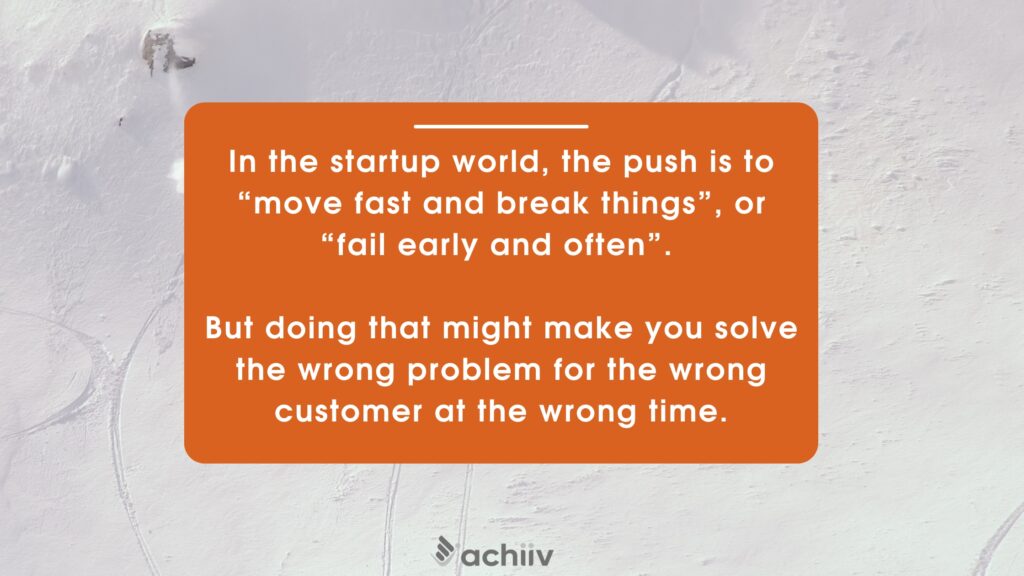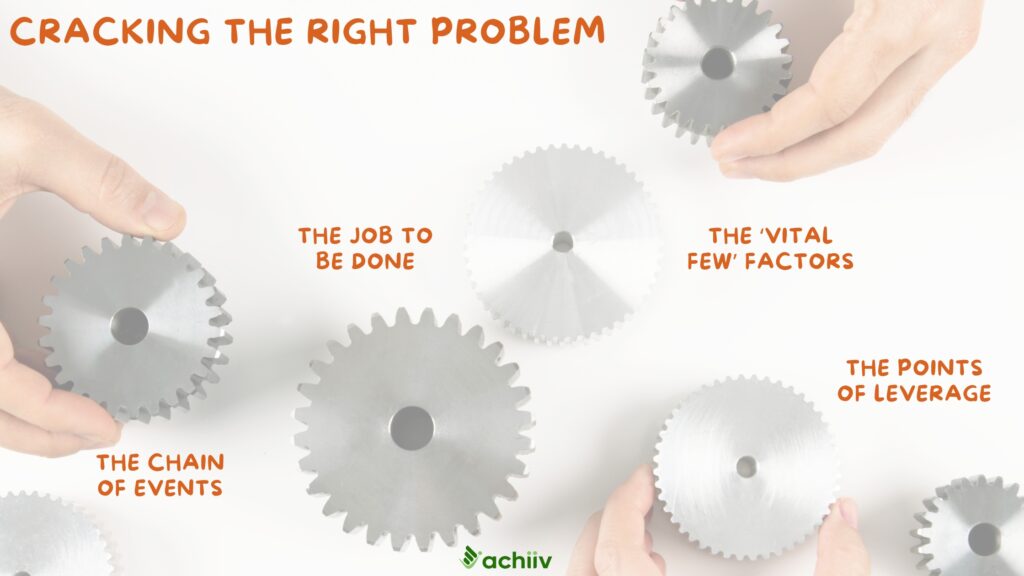There’s a problem in the startup world that I rarely see addressed. It can trip up your efforts in a big way, and is invisible unless you’re trained to look for it.
Here’s how it often plays out:
- Aspiring founder sees a big problem, and feels compelled to find a way to solve it
- Founder faithfully follows the customer discovery process, interviews multiple customers
- She collects enough data, validates the pain point, establishes willingness to pay, and sets out to build the product
With the results in hand, she confidently launches a product to solve a burning problem everybody agrees is big, profitable to solve and that needs to be solved. The product is launched with much fanfare.
It withers and dies, never having taken off.
Why Customer Discovery Can Lead You Astray
The most powerful tool in the world thoughtlessly used can backfire. Customer development is a classic example. It’s necessary but not sufficient to build a viable business. Success doesn’t come from just providing what customers want, or even by solving customers’ real problems.
The issue is deeper than realizing that you need to build a motor car to address customers’ demands for faster horse buggies. For your business to be truly successful, an invisible issue has to be addressed: industry dynamics and the value chain.
Let’s say you’re frustrated by how hard it is for homeowners to switch to renewable energy sources. You conduct extensive customer interviews with homeowners and realize that they want more convenient access to renewable energy providers in one place, with information on costs and terms for easy comparison. So you listen to the market and develop an online renewable energy marketplace for homeowners.
But for your business to succeed, it’s not enough that customers love having one-stop access and that suppliers are willing to pay you to be featured there. Your solution needs to ensure that the customer gets what they were looking for in the first place: a reliable and affordable source of energy they can trust. For this to happen, you need to solve the problem in a way that can succeed within the context of how that industry works.

What Really Drives Your Startup’s Success
In this example, for your business to succeed long-term, you need to have lots of homeowners not only checking out different energy providers, but also following through with purchase and maintenance contracts. Otherwise usage will fade away and your marketplace will die quickly.
What drives homeowners to follow through on their renewable energy intentions? It’s things like:
- Installation terms and specifications
- Provider quality and reputation
- Installer availability, cost and reliability
- System performance and maintenance when support is needed
- Reliable grid connection and metering with their existing utility companies
In other words, key elements of how the industry works and how things get done.
In today’s startup world, there’s a tendency, after the customer discovery is done, to “move fast and break things, or “fail early and often”. In your enthusiasm to execute, you may be tempted to solve the surface problem, and create the obvious answer, say an energy marketplace.
But by doing that, you throw away an opportunity to truly understand the “iceberg” factors at play that can make or break your solution, even though that may feel less satisfying and glamorous in the short term.
Slowing down for true understanding involves asking questions like:
- What is the sequence of events that needs to happen for this problem to be truly and completely solved?
- What is the real solution, the real job to be done for the customer or user?
- Which are the one or two make or break factors that will determine success or failure for the solution?
- In this value chain, what is the one point of leverage where YOU as the entrepreneur have real ability to influence?
When you take the time to do so, you’ll be rewarded with better insights and richer opportunities for business AND impact.
The problem of renewable energy for homes, for example, is truly solved when homeowners can not only find but also follow through with the right renewable energy solution for their needs and budgets. For this to happen, yes they need to find the providers, but they also need to follow through on the purchase and installation process so that they pick the right energy solution they can afford and live with.
How to Go From Discovery to Insight
This pause gives you room to discover the key way points that need to work in your customer’s quest to decarbonize their homes and live happily ever after:
- Geographic location and renewable energy suitability rating
- Cost of an installation
- Current utility provider
- Available installers in their location
- Local zoning regulations regarding installations
Looking at this, you may come to realize that you have limited ability to influence geographic location and suitability (a big driver) but you do have a lot more leverage in building a tech tool that helps homeowners monitor and optimize energy usage in their microgrid.
Such a tool not only helps the homeowner optimize long term energy costs, but also helps their utility company optimize energy usage and balance energy loads across the grid – a win for all players in the game. Monetization becomes easier and much more sustainable, with the possibility of new revenue streams not too far in the future.
Voila! You’ve just found a much better answer for the problem than something that a mere customer discovery exercise would have given you. With the added benefit of possibly less competition from other entrepreneurs who haven’t taken the time to really dig deep like you have.
You’ll also avoid wasting months of your life by not rushing to solve the customers’ surface problem just because you’ve completed customer discovery and have checked the boxes on some standard recipe.

How to Make Entrepreneurial Insight Actionable
You don’t have to spend months poring over industry structure maps or hire expensive consultants to get this right. Some basic knowledge, a sharp questioning mind, and a little elbow grease can get you leaps and bounds ahead in your journey:
- Draw a simple map of what it takes from start to finish for the customer’s entire problem to be solved.
- Mark every key player who needs to play in the chain, and what they need to do for the problem to be solved
- Find the few vital links that can turn the solution from “on” to “off” if they don’t work right
- From this small set, figure out which point of leverage you’re qualified to play in and have a reasonable chance of success.
- Check to see if your new solution makes a step-level difference in the customer’s life – e.g., significantly better, faster, easier
- Only then start developing prototypes or possible solutions to address real problems you can build a business on
Doing this will take a little longer than jumping into solutions immediately. It may even feel a little less satisfying than finding solutions that look attractive on the surface or are more “sexy” than real solutions that solve real problems.
If you’re solving a hiring problem for employers, for example, the obvious answer may be a better job board with deep AI capabilities. But the deeper dive may open up opportunities for real-time upskilling for existing employees – an opportunity that probably a lot fewer entrepreneurs are competing to solve for, just because they didn’t stop to look or think.
The true validation will come when your more substantive solution begins to sail through its actual journey much faster and smoother in real life, creating not only happier customers but also a fatter wallet for your business long term.
You’ll also love the unexpected side benefits of potential new product and revenue opportunities, greater industry authority, and the possibility of much more enduring impact.
Would you rather do this? Or stick to the old “just go and do it” trope?
Ready to make it happen? What problem are you trying to solve now? How can you test it to see if it will meet the real world challenge of the customer’s journey?







